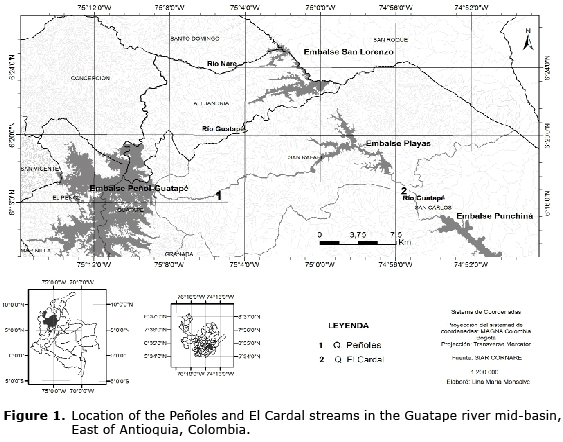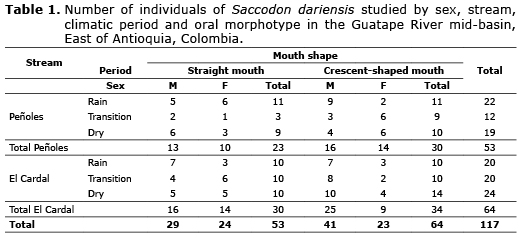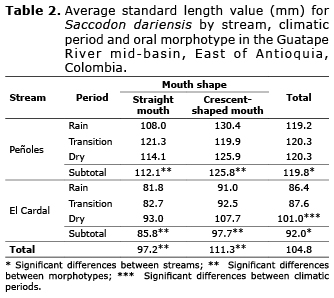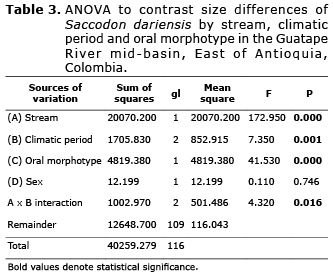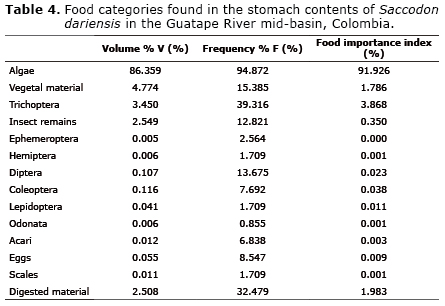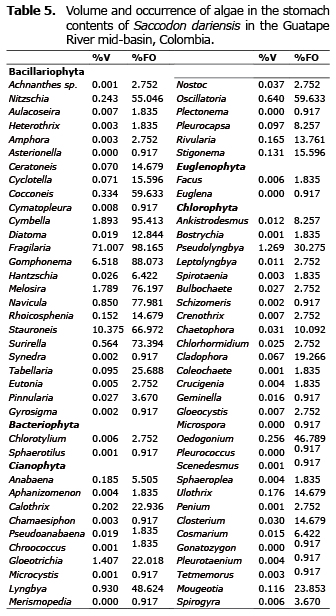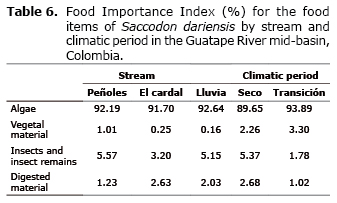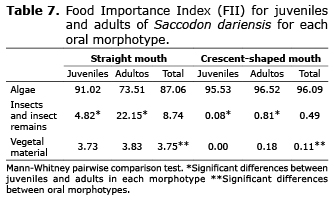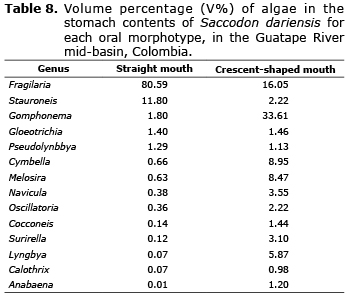Services on Demand
Journal
Article
Indicators
-
 Cited by SciELO
Cited by SciELO -
 Access statistics
Access statistics
Related links
-
 Cited by Google
Cited by Google -
 Similars in
SciELO
Similars in
SciELO -
 Similars in Google
Similars in Google
Share
Revista MVZ Córdoba
Print version ISSN 0122-0268
Rev.MVZ Cordoba vol.19 no.1 Córdoba Jan./Apr. 2014
ORIGINAL
Trophic ecology of Saccodon dariensis (Pisces: Parodontidae) in Guatapé River tributaries, Magdalena River Basin, Colombia
Ecología trófica de Saccodon dariensis (Pisces: Parodontidae) en afluentes del río Guatapé, Cuenca río Magdalena, Colombia
Ana Restrepo-Gómez,1 Zoot, Néstor Mancera-Rodríguez,1* Ph.D.
1Universidad Nacional de Colombia, Departamento de Ciencias Forestales. Posgrado en Bosques y Conservación Ambiental. Medellín, Colombia.
*Correspondence: njmancer@gmail.com
Received: April 2013; Accepted: September 2013.
ABSTRACT
Objective. To study the trophic ecology of Saccodon dariensis in the Peñoles and El Cardal streams, Guatape River mid-basin, Magdalena River Basin, Colombia. Materials and methods. To compare differences in size between individuals from the two streams in terms of hydrologic periods, oral polymorphisms or sexes, an analysis of variance was conducted (ANOVA). Volume percentages, frequency of occurrence and the food importance index (FII) were determined; a principal component analysis (PCA) and an ANOVA was carried out to determine the diet differences between streams, climatic periods, oral polymorphism, sexes and developmental states, as well as a Mann-Whitney pairwise comparison test for each food category. Results. A significant difference was found in size between individuals of the two streams with different oral polymorphism. Algae are the most important food item (FII: 91.9%), followed by Trichoptera and insect remains (FII: 4.3%), and vegetal material (FII: 1.8%). The PCA did not indicate significant differences in diet between streams, climatic periods, oral polymorphisms, sexes or developmental states, but the ANOVA and Mann-Whitney pairwise comparison test indicated differences in oral morphotype, where individuals with a straight mouth consumed more vegetal material. We also observed different proportions in consumption of different algae genera, and increased consumption of insects in ontogeny, this being higher in individuals with a straight mouth. Conclusions. The species is algaevorous. The oral morphotypes of S. dariensis may be related to a trophic polymorphism that confers different trophic habits and differential access to the items that constitute their diet.
Key words: Algae, conservation, fish feeding, polymorphism (Source: AIMS, CAB).
RESUMEN
Objetivo. Estudiar la ecología trófica de Saccodon dariensis en las quebradas Peñoles y El Cardal, parte media del río Guatape, cuenca del rio Magdalena, Colombia. Materiales y métodos. Para contrastar diferencias entre individuos de las dos quebradas en cuanto a períodos hidrológicos, polimorfismos bucales y sexos se realizó un análisis de varianza (ANOVA). Se determinó los porcentajes de volumen, frecuencia de ocurrencia e índice de importancia alimentaria (IIA); se realizó un análisis de componentes principales (ACP) y un ANOVA para determinar diferencias de dieta entre quebradas, períodos climáticos, polimorfismos bucales, sexos, estados de desarrollo, y una prueba de comparación por pares de Mann-Whitney para cada categoría de alimento. Resultados. Se encontró diferencia significativa en la talla entre individuos de las dos quebradas con diferente morfotipo bucal. Las algas es el ítem de alimento más importante (IIA: 91.9%), seguido por Trichoptera y restos de insectos con (IIA: 4.3%) y material vegetal (IIA: 1.8%). El ACP no indicó diferencias en la alimentación entre quebradas, períodos climáticos, polimorfismo bucal, sexos o estados de desarrollo, pero la ANOVA y la prueba de Mann-Whitney indicaron diferencias por morfotipo bucal, donde individuos de boca recta consumen más material vegetal. Se observó en proporciones diferentes el consumo de diferentes géneros de algas, y aumento de consumo de insectos en ontogenia, siendo más alto para individuos de boca recta. Conclusiones. La especie es alguivora. Los morfotipos bucales en S. dariensis pueden estar relacionados con un polimorfismo trófico que le confiere diferentes hábitos tróficos y acceso diferencial a los ítems que constituyen su dieta.
Palabras clave: Algas, alimentación de peces, conservación, polimorfismo (Fuente: AIMS, CAB).
INTRODUCCIÓN
Colombia has the highest diversity in mountain fish species within the Andean region, with approximately 220 species, of which around 37% are endemic (1). However, this diversity is vulnerable to current environmental changes generated by man, such as the alteration of ecosystems by fragmentation and deforestation, loss and pollution of water bodies, introduction of exotic species, alteration of water regulation dynamics with the development of hydroelectric plants and high pressure on hydrobiological resources (2), that diminish natural populations; placing many fish species in the brink of extinction. Despite this problem, still there is little knowledge of many aspects of the trophic ecology of Andean fish, and knowing them would help establishing recommendations for their protection, conservation and handling.
The family Parodontidae consists of the genera Parodon Valenciennes 1849 and Saccodon Kner 1863 (3), which have a wide geographical distribution in Central and South America, from the Panama Canal to the basin of Rio de la Plata in Argentina, except in the basins to the south of the State of Bahia in Brazil in the Atlantic Coast, Patagonia, and the channel of the Amazon River (4). They mostly do not exceed 20 cm in length, have no commercial importance (4-5), and preferentially consume algae and aquatic insects (4, 6-10), although Parodon cf. gestri has been placed within the detrivores group (11).
Saccodon dariensis (Meek Hildebrand, 1913) is distributed in Central and South America, in inland waters to the east of the Panama Canal and in Colombia in the basins of the rivers Atrato and Magdalena (4,12), in particular in the departments of Cauca and Valle del Cauca (13-14), Tolima (15) and Antioquia (1, 16-17). The species is associated with sites that have fast-flowing currents, low slopes and rocky substrates covered with periphyton.
Intraspecific morphological differences have been reported in several wildlife species, which have been described as "trophic polymorphism," being related to the structures responsible for food and which can confer advantages in the use of the habitat and specific resources (18). Roberts (5) has noted five oral and dental polymorphisms for Saccodon dariensis in tributaries of the rivers Sinu, Magdalena, upper Cauca and Atrato, and mentions the relationship of these and the possible differences in the exploitation of food resources. In the Guatape River basin, the coexistence of two of these oral polymorphisms has been described. The species has highly specialized teeth to scrape algae attached to the bedrock in aquatic ecosystems. Some morphotypes have premaxillary teeth in a straight line and others have 6 or 8 crescent-shaped teeth; consumes aquatic insects from the Diptera, Trichoptera, Ephemeroptera, and Plecoptera order that adhere to the surface of the rocks (10).
The objective of this study was to study the trophic ecology of the mazorco, Saccodon dariensis, in the Peñoles and El Cardal streams, Guatape River mid-basin, Magdalena River basin, and to determine if there are significant differences in diet between sexes, developmental states, streams and climatic periods, and if oral polymorphism (straight mouth vs. crescent-shaped mouth) is related to a trophic polymorphism. This information is important for the formulation of programmes for the conservation and handling of the species, which is included in the Red Book of Freshwater Fishes of Colombia in the category of Minor Concern (10).
MATERIALS AND METHODS
Study area. The study was carried out in the Peñoles (6°16'27.2" N, 75°05'23.7" W; 1201 masl) and El Cardal streams (6°16'46.6" N, 74°55'24.6" W; 898 masl), tributaries of the Guatape River, Magdalena River basin, in the municipalities of San Rafael and San Carlos in the region east of Antioquia, Colombia (Figure 1).
The area shows tropical moist biome ecosystems characteristic of the Magdalena River valley, with an average temperature of 23-28°C (19), and a bimodal precipitation distribution pattern with rainfall peaks in May and October, and an annual average of 4368 mm (Embalse de las Playas weather station). The territory is mountainous, with an undulating topography, and the streams are characterized by being torrential, with very clear water and no alluvial plains.
Habitat characterization. The following physicochemical variables were taken in situ: dissolved oxygen (mg/l), oxygen saturation (%), surface water temperature (°C) with HANNA meter (HI9828/4-01) and pH, conductivity (µS/cm) and total dissolved solids (TDS) with HANNA meter (9811-5). The width and depth were measured with a measuring tape, and a rod in centimeters and the type of substrate was classified according to the scale proposed by Wentworth (20).
Obtaining of samples. Six field samplings were carried out which included periods of rain (October and November 2007, May 2008), draught (January to March 2010) and dry to rain transition (March 2008). Specimens were captured with 30 sets of cast nets with chain links of 1 cm by station and with SAMUS 725MP electrofishing equipment, which was used on a linear stretch of 100 m per station, sweeping against the current, and from bank to bank, which included all possible biotopes. Once captured, fish were tagged with date, place of catch and fishing gear, they were placed in plastic bags and left in formalin at 10%. The identification of stomach contents was carried out in the Wildlife Ecology and Conservation Laboratory of Universidad Nacional de Colombia, Medellin. The specimens of S. dariensis were preserved in alcohol at 70% and are stored in the Ichthyology Laboratory of Universidad del Quindio, Armenia, Colombia (IUQ) and in the Limnology and Water Resources Laboratory of Universidad Catolica de Oriente, Rionegro, Antioquia, Colombia (UCO).
Analysis of stomach contents. The specimens collected were washed with water to remove the excess of formaldehyde and then were put in alcohol at 70%. In total 117 stomachs of individuals of S. dariensis were examined, of which 53 were captured in the Peñoles stream and 64 in the El Cardal stream. Of these 70 were females and 47 males, and 53 had a straight mouth and 65 a crescent-shaped mouth (Table 1).
The standard length (SL) in mm of the specimens was measured with a digital gauge (Mitutoyo 500 Series) up to hundredths of a mm and the total (g) and eviscerated weight (g) with an analytical scale (Ohaus Scout Pro SP202, New Jersey, USA) up to two tenths of precision (0.01g) and underwent a ventral dissection for extracting gonads for gender identification and the digestive tract, with which the length and width of the stomach, the length of the intestine and the number of pyloric caeca was measured. An analysis of variance (ANOVA) was performed to contrast the differences in size between streams, hydrological periods, oral polymorphisms and sexes. A linear correlation was made between the standard length (SL) and the length of the intestine, the standard length (SL) and the length of the stomach, the standard length (SL) and the width of the stomach, and a potential correlation between the total weight of the fish vs. its standard length.
For the analysis of the diet, a separation of easily recognizable food categories was made with a EZ4 stereoscope (Leica Microsystems) and the rest of the stomach and intestine contents were diluted in 2 ml of distilled water, drops (known volume subsamples) were taken and observed under a microscope (Leica Microsystems). The separation and identification of nutritional elements was carried out in a qualitative and quantitative basis according to the volumetric and frequency of occurrence methods (21,22), and the food importance index (FII) was calculated according to Kawakami and Vazzoler (23) FII=Fi*VI/Σ(Fi*Vi), where FII = food importance index, Fi= frequency of occurrence (5) of each category and Vi=volume (%) of each category. The taxonomic determination of the different items was based on taxonomic cues (24-28).
Analysis of information. A principal components analysis was performed to establish significant differences in diet between streams (Peñoles and El Cardal), climatic periods (rain, transition and drought), oral polymorphism (straight mouth or crescent-shaped mouth), and developmental state (youth and adults), and a Mann-Whitney pairwise comparison test was conducted to determine if there are differences in the consumption of each food category by mouth type and developmental state. For the developmental states the fish was separated into two size categories, those considered young corresponded to individuals with a length less than the mean size at sexual maturity of 88.8 mm standard length for females and 109.3 mm for males, as established by Urrego-Ballestas et al (17) and adults as those individuals with a length equal to or greater than these values.
RESULTS
Habitat characteristics. The Peñoles stream is characterized by having a rocky or pebbly substrate, with an incline with an angle of approximately 25°, and the presence of large rocks was observed upstream the sampling site. During the dry season, its waters are crystal clear and in the rainy season they are turbid with a strong current. A native forest and some pasture for livestock were observed on its banks. Fifty meters before the mouth of the Guatape river there is a concrete-steel road that crosses the stream for vehicle access to a farm, becoming a barrier mainly during the dry season, when the flow of the stream is low. It has an average depth between 0.40-0.60 m, albeit with some deeper pools. The average width was 16.5 m with a maximum of 17.9 m in the rainy season and a minimum of 14.6 m in the dry season. The surface temperature of the water was on average at 19.6°C, oxygen dissolved was 10.2 mg/l, the oxygen saturation percentage 119%, conductivity 17.3 µS/cm, total solids dissolved 16.3 and the pH 7.5.
The El Cardal stream has a sandy-pebbly substrate, with large rocks upstream the sampling sites, on both banks the land is predominantly used locally for livestock pastures in the area close to the mouth in the Guatape River and on the right bank of the stream there is a residential camp of Empresas Publicas de Medellin which carries out discharges into the stream; and the highest parts are dominated by a native forest in good state of conservation. It has an average depth between 0.30 - 0.60 m, albeit with some deeper pools. The average width was 11.1 m with a maximum of 12.3 m in the rainy season and a minimum of 9.1 m in the dry season. The surface temperature of the water was on average at 20.8°C, dissolved oxygen was 7.5 mg/l, oxygen saturation percentage 76%, conductivity 62.7 µS/cm, total solids dissolved 42.3 and pH 7.3
Characteristics of specimens and diet. The individuals of S. dariensis analyzed were fish with a standard average length of 104.8 mm (standard deviation of 19.3) with sizes between 72.3 mm and 156.2 mm. In the sampling zones a significant difference in size between the specimens captured in the two streams (p=0.000) is observed, for the Peñoles stream the mean standard length size (SL) of individuals studied was 119.8 mm (standard deviation of14.1, Min 90.3, Max. 156.2) and 92 mm for El Cardal stream (standard deviation of 12.8, Min 72.3, Max. 138.9). A significant difference by oral morphotype is also observed (p=0.000) in the standard length between individuals with a crescent-shaped mouth which are larger that those with a straight mouth in the two streams, and a significant difference was observed in the climate period (p=0.001) during the dry season in the El Cardal stream in which the average SL size was 101 mm, while for the transition period it was 87.6 mm and in the rainy season of 86.4 mm (Table 2 and 3).
The stomachs of S. dariensis show a saccular form, being longer (average of 18.0 mm;) standard deviation of 4.6) than wider (average of 8.0 mm; standard deviation of 2.4). The average intestine length was 86.5 mm (standard deviation of 24.8). From two to ten pyloric caeca were observed being 8 the most frequent number (average: 6.18, standard deviation of 1.7). A positive and average correlation was observed between the standard length (SL) vs. the intestine length vs. (intestine length=0.9325*(SL)-9.1881, r=0.76, n=112), standard length (SL) vs. stomach length (stomach length=0.1665*(SL) + 0.6756, r=0.77, n=111), standard length (SL) vs. stomach width (stomach width=0.0862*(SL) - 1.1573, r=0.75, n=112); while the weight total vs. standard length showed a high correlation (fish weight=0.00004*(LE)3.334, r=0.98, n=117).
Of the total of 117 stomachs, only 2 (1.7%) were found empty. The stomach contents of the 115 stomachs were grouped into 14 food items. Of these, the most important was algae (V: 86.4%; FO: 94.9%; FII: 91.9%), followed by Trichoptera (V: 3.4%; FO: 39.3%; FII: 3.9%), vegetal material (V: 4.8%; FO: 15.4%; FII: 1.8%) and insects remains (V: 2.5%; FO: 12.8%; FII: 0.4%) (Table 4).
Seventy-four genera with five divisions were recorded for algae: 29 genera of Chlorophyta, 25 of Bacillariophyta, 16 of Cianophyta, 2 of Bacteriophyta and 2 of Euglenophyta. In the volumetric analysis the most important divisions were Bacillariophyta (94.1%), Cianophyta (3.8%) and Chlorophyta (2.1%). Thus, the most important genera were Fragilaria (V: 71.0%; FO: 95.4%), Stauroneis (V: 10.4%; FO: 67.0%), Gomphonema (V: 6.5%; FO: 88.1%), Cymbella (V: 1.9%; FO: 95.4%), Gloeotrichia (V: 1.4%; FO: 22.0%) and Pseudolyngbya (V: 1.3%; FO: 30.2%) (Table 5).
The principal components analysis (PCA) does not show any differences in feed between streams, climatic periods, oral polymorphism, sex or developmental state. The most important food item in the two streams was algae with an FII of 92.19% and 91.70%, followed by insects and insect remains with an FII of 5.57% and 3.20% for the Peñoles and El Cardal streams, respectively. By climatic periods, there is an increase in the consumption of vegetation material in the dry period (2.26%) and in the transition period (3.30%) in relation to the rainy period (0.16%), and in the consumption of insects, especially of the order Trichoptera, which is greater in rainy and dry periods (Table 6).
The food importance index (FII) shows for individuals with a crescent-shaped mouth that the main food item in their diet is algae (96.1%) and a low consumption of insects and insect remains (0.49%), and vegetation material (0.11%). Moreover, individuals with a straight mouth showed a reduction in the consumption of algae, although it remains the main food item in their diet with 87.10%, but the consumption of insects and insect remains is higher at 8.74% and vegetation material with 3.75%. The analysis of variance (ANOVA) to identify differences between diets showed significant differences (p=0.038) only by oral morphotype for the consumption of vegetation material, which is higher in individuals with a straight mouth and the specific comparison between food items with the Mann-Whitney pairwise comparison test indicates significant differences by oral morphotype for the consumption of vegetation material being higher in individuals with a straight mouth (p=0.034) (Table 7).
A significant increase in the consumption of insects was found within the two morphs when passing from youth to adults (straight mouth: p=0.034, crescent-shaped mouth: p=0.000), being this the highest for individuals with a straight mouth as they went from 4.82% to 22.15% of the FII (Table 7).
A variation was observed in the volume consumed of the different genera of algae between individuals with a different type of mouth. For specimens with a straight mouth, the most important genera are Fragilaria (V%: 80.6) and Stauroneis (V%: 11.8); while for those with a crescent-shaped mouth there is an importance in the consumption of a greater variety of genres, being Gomphonema the most important with (V%: 33.6), followed by Fragilaria (V%: 16.1), Cymbella (V%: 8.9), Melosira (V% 8.5), Lingbya (V% 5.9), among others (Table 8).
DISCUSSION
Saccodon dariensis showed a higher mean size in the Peñoles stream (SL 119.8mm) in relation to individuals captured in the El Cardal stream (SL 92mm), which may be related to the fact that the Peñoles stream is wider and deeper. This is consistent with what has been described by Restrepo-Escobar (29), for specimens of Brycon henni in the middle basins of the Nare and Guatape rivers (Colombia), where a significant differences in size was found, with the largest individuals being caught in rivers and streams with a higher average flow and water column depth. The high percentage of individuals below the mean size at sexual maturity (17) in the El Cardal stream, allows us to infer that it is an important area for growth and development. The comparison of the average standard length between mouth types showed that individuals with a crescent-shaped mouth had a larger average size than those with a straight mouth in the two streams, which has been described for the species by Restrepo-Escobar (29), suggesting responses for morphotypes different to the factors influencing the size that could be determined genetically or reflect a phenotypic plasticity.
Saccodon dariensis feeds almost exclusively on algae, mainly Bacillariophyta or diatoms that represent the highest densities (V%=94.1) and is the most frequent and important item in all contents studied both in juvenile stages as in adults. Diatoms belonging to the family naviculaceae have adapted to streams with high flow rates or systems with a high incidence of sediment entrainment or that have been influenced by significant runoffs, which also usually consist of certain substances with a high energetic value, therefore constituting an important offer for macroinvertebrates and fish that feed on periphytic algae (25).
On the other hand, a significant increase in the consumption of insects was found when going from youth to adults, mainly individuals with a straight mouth where they pass from 4.8% to representing more than 22% of the FII, the consumption of Trichoptera insects stands out and within this, Helycopsichidae, which possess scraping jaws to obtain periphyton and fine particles that cover the surface of rocks. The low proportion of insect categories in the diet and their lower frequency of occurrence allow inferring that the ingestion of animal material is probably very seldom. In this regard, Zamudio et al (9) and Mojica-Corzo et al (10) indicate the consumption for S dariensis of aquatic insects of the orders Diptera, Trichoptera, Ephemeroptera, and Plecoptera that adhere to the surface of the rocks, which are caught with the help of their upper teeth. Likewise, other authors (4,7-10) have found that the species of Parodontidae preferentially consume algae and aquatic insects. Parodon caliensis accidentally consumes periphyton and inorganic material, but shows a greater preference for aquatic insects (Ephemeroptera, Trichoptera, Plecoptera and Diptera) and terrestrial insects (Hymenoptera family Formicidae and Coleoptera), Parodon buckleyi in the foothills of the Colombian Orinoquia feeds mainly on algae and P. suborbitalis in the upper Cauca feed on algae and organic matter scraped from rocks and aquatic insects that lie in the gravel (13).
In conclusion Saccodon dariensis is a mainly algaevorous species with occasional consumption of insects and vegetation material and no differences were found in the comparison of diet by areas and climate period. The oral morphotypes of S. dariensis may be related to a trophic polymorphism given the significant differences with the increased consumption of vegetation material in individuals with a straight mouth (p=0.034), as well as different proportions in the consumption of different genera of algae between the two morphotypes (for individuals with an straight mouth the most important genera were Fragilaria and Stauroneis, while for those with a crescent-shaped mouth there is a greater importance in the consumption of a greater variety of genres, with Gomphonema being the most important), and the increase in the consumption of insects when going from youth to adults, being this higher for individuals with a straight mouth. It is possible that these differences in diet are justified by the type of mouth and the shape of the teeth described by Roberts (5) for the two morphotypes, which provides differences for access to food resources, as the fish with a straight mouth with cusped teeth are able to access the resource by foraging filamentous algae nibbled above the substrate, occasionally ingesting in this process insects and other vegetal material, while fish with a crescent-shaped mouth make it by scrapping, as they obtain algae close to the substrate using their spoon-shaped smooth teeth.
These forms for obtaining benthic algae acting as foragers or scrapers have also been described for Parodon tortuosus (7). Finally, changes in these diet components may be associated with differences in the size of specimens between morphotypes, having different nutritional influences, but this must be explored through diet studies from stable isotopes (30).
Acknowledgements
The Autonomous Regional Corporation of the Negro and Nare rivers (CORNARE), ISAGEN S.A. E.S.P. and Universidad Nacional de Colombia, which funded the project 20101009235: "Study of the biology, ecology and genetic diversity of natural populations of Brycon henni in the basins of the Nare and Guatape rivers, department of Antioquia," where the biological material analyzed in this study was collected. To the Medellin Research Department - DIME and the Dean's Office for Research of the Faculty of Agricultural Sciences of Universidad Nacional de Colombia. Professor Alvaro Lema for his support with statistical analysis and the anonymous reviewers for their commentaries.
REFERENCES
1. Jaramillo-Villa U, Maldonado-Ocampo JA, Escobar F. Altitudinal variation in fish assemblage diversity in streams of the central Andes of Colombia. J Fish Biol 2010; 76:2401-2417. [ Links ]
2. Anderson E, Maldonado-Ocampo JA. A Regional Perspective on the Diversity and Conservation of Tropical Andean Fishes. Conserv Biol 2011; 25(1):30-39. [ Links ]
3. Londoño-Burbano A, Román-Valencia C. Redescripción de Parodon caliensis y Saccodon dariensis (Characiformes: Parodontidae). Rev Biol Trop 2010; 58(3):813-826. [ Links ]
4. Reis RE, Kullander SO, Ferraris CJ (eds.) Checklist of the Freshwater Fishes of South and Central America. Porto Alegre Brasil: EDIPUCRS; 2003. [ Links ]
5. Roberts T. Dental polymorphism and systematics in Saccodon, a neotropical genus of freshwater fishes (Parodontidae, Characoidei). J Zool Lond 1974; 173:303-321. [ Links ]
6. Melo CE, Machado FA, Pinto-Silva V. Feeding habits of fish from a stream in the savanna of Central Brazil, Araguaia Basin. Neotrop Ichthyol 2004; 2(1):37-44. [ Links ]
7. Pelegrin N, Haro JG. Ecología alimentaria de Parodon tortuosus (Pisces, Characiformes) en el Río de La Suela, Córdoba (Argentina). Ecol Austral 2004; 14(1):45-51. [ Links ]
8. Rodríguez-Olarte D, Coronel JA, Taphorn D. Línea base para la estimación de la integridad en comunidades de peces en la cuenca del río Tocuyo, vertiente del Caribe, Venezuela. Mem Fund La Salle de Cienc Nat 2007; 165:63-81. [ Links ]
9. Zamudio J, Urbano-Bonilla A, Maldonado-Ocampo JA, Bogotá-Gregory JD, Cortés-Millán GA. Hábitos alimentarios de diez especies de peces del piedemonte del departamento del Casanare, Colombia. Dahlia Rev Asoc Colomb Ictiol 2008; 10:43-56. [ Links ]
10. Mojica-Corzo JI, Usma-Oviedo JS, Álvarez-León R & Lasso-Alcalá CA (eds.). Libro rojo de peces dulceacuícolas de Colombia. Bogotá D.C.: Instituto de Investigación de Recursos Biológicos Alexander von Humboldt; 2012. [ Links ]
11. Pouilly M, Barrera S, Rosales C. Changes of taxonomic and trophic structure of fish assemblages along an environmental gradient in the upper Beni Watershed (Bolivia). J Fish Biol 2006; 68:137-156. [ Links ]
12. Maldonado-Ocampo JA, Vari RP, Usma JS. Checklist of the Freshwater Fishes of Colombia. Biota Col 2008; 9(2):143-237. [ Links ]
13. Ortega-Lara A, Aguiño A, Sánchez GC. Los peces del Alto Cauca: Caracterización de la ictiofauna nativa de los principales ríos de la cuenca alta del río Cauca en el departamento del Cauca. Popayán, Colombia: Fundación para la investigación y el Desarrollo Sostenible, FUNINDES y Corporación Autónoma Regional del Cauca CRC; 2002. [ Links ]
14. Amaya JD, Naranjo LG. Plan Nacional de las Especies Migratorias: Diagnóstico e identificación de acciones para la conservación y el manejo sostenible de las especies migratorias de la biodiversidad en Colombia. Bogotá, Colombia: MAVDT - WWF; 2009. [ Links ]
15. Villa-Navarro F, Briñez-Vásquez AN, Castro-Roa D, García-Melo LJ, García-Melo JE, Herrada-Yara ME. Biodiversidad faunística y florística de las cuencas de los ríos Prado y Amoyá - Biodiversidad Regional Vol. II. Ibagué, Colombia: Cortolima y Universidad del Tolima; 2005. [ Links ]
16. Jaramillo-Villa U, Maldonado-Ocampo JA, Bogotá-Gregory JD. Peces del Oriente de Antioquia, Colombia. Biota Col 2008; 9(2):279-293. [ Links ]
17. Urrego-Ballestas DA, Castellanos-Barliza JJ, Mancera-Rodríguez NJ. Biología reproductiva de Saccodon dariensis (Pisces: Parodontidae) en la cuenca media del río Guatapé, Antioquia - Colombia. En: III Congreso Colombiano de Zoología; Medellín, Colombia. [ Links ]
18. Olsson J, Eklöv P. Habitat structure, feeding mode and morphological reversibility: factors influencing phenotypic plasticity in perch. Evol Ecol Res 2005; 7:1109-1123. [ Links ]
19. Rodríguez N, Armenteras D, Morales M, Romero M. Ecosistemas de los Andes colombianos. Bogotá, D.C.: Instituto de investigación de recursos Biológicos Alexander von Humboldt; 2004. [ Links ]
20. Wentworth C. A scale of grade and class terms for clastic sediments. J. Geology 1922; 30:377-392. [ Links ]
21. Ricker WE. Methods for assessment of fish production in fresh waters. 2ª ed.- 2nd ed. Oxford: I.B.P. Handbook No 3. Blackwell Sci Publ; 1971. [ Links ]
22. Hyslop EJ. Stomach contents analysis a review of methods and their applications. J Fish Biol 1980; 17:411- 429. [ Links ]
23. Kawakami E & Vazzoler G. Método gráfico e estimativa de alimentar aplicado no estudo de alimentação de peixis. Bol Inst Oceanogr 1980; 29(2):205-207. [ Links ]
24. Bicudo CE, Menezes M. Géneros de algas de aguas continentales do Brasil. Sao Carlos, Brasil: Editorial Rima; 2006. [ Links ]
25. Ramírez JJ. Fitoplancton de agua dulce: aspectos ecológicos, taxonómicos y sanitarios. Medellín Colombia: Editorial Universidad de Antioquia; 2000. [ Links ]
26. Krammer K, Lange-Bertalot H. Bacillariophyceae. Tomos 1,2,3,4. Berlin, Alemania: Verlag; 1949. [ Links ]
27. Streble H, Krauter D. Atlas de los microorganismos de Agua dulce. Barcelona, España: Editorial Omega S.A.; 1987. [ Links ]
28. Roldán-Pérez G. Guía para el estudio de los macro invertebrados acuáticos del departamento de Antioquia. Bogotá, Colombia: Fondo FEN Colombia, Colciencias y Universidad de Antioquia; 1996. [ Links ]
29. Restrepo-Escobar N. Brycon henni y Saccodon dariensis (Pisces: Characiformes): Análisis de la variación del cuerpo mediante el uso de la Morfometría geométrica. [Tesis de M.Sc.]. Medellín, Colombia: Universidad Nacional de Colombia, Facultad de Ciencias, Escuela de Biociencias; 2013. [ Links ]
30. Adams CE, Fraser D, McCarthy I, Shields S, Waldron S, Alexander G. Stable isotope analysis reveals ecological segregation in a bimodal size polymorphism in Arctic charr from LochTay, Scotland. J Fish Biol 2003; 62:474-481. [ Links ]













